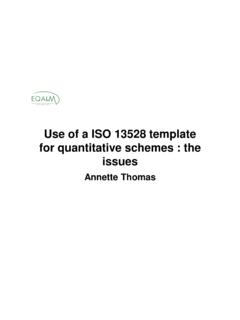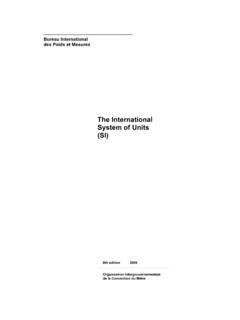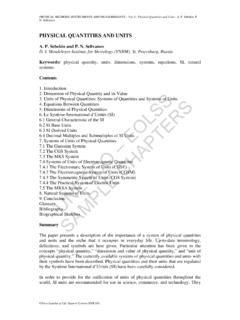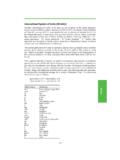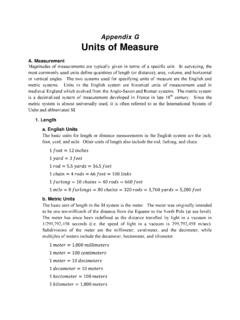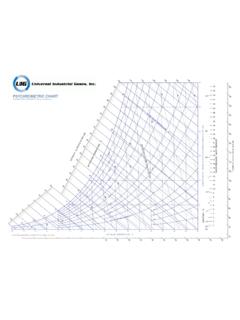Transcription of The Problem of the Use of different Units for the same Analyte
1 The Problem of the Use of different Units for the same AnalyteLabqualityAnalyteEQALM Symposium 2009 Ulla of results Measurement traceability to the reference material or procedures Measurement traceability to international system of Units -SI unitsLabqualitySystem of Units -SI Units Interchange of information between laboratoriesComparability of results Of the seven base SI- Units the mass unit kilogramand unit for substance amount moleare the ones are mostly used in clinical chemistryLabqualityclinical chemistry Several non-SI but internationally accepted Units : litre, IU Traceability to international coventional standardsUnit used in EQA schemes Aim to follow international agreements Specific instructions on the recording and reporting the test results are supplied to laboratories ( Units and significant Labqualitylaboratories ( Units and significant figures).)
2 Regardless of detailed instructions the data an EQA-coordinator receives contains results with various unitsChallenges in Units easy to handle conversion (creatinine) Units close to each other (alpha-fetoprotein) same standards but different conversion Labquality same standards but different conversion factors from different reagent producers (prolactin) manufacturer has assays with the different standardisations for the same Analyte (growth hormone)Creatinine Traceable to IDMS refererence method SI unit mol/L, unit conversion factor from mg/dL 25% of laboratories reported creatinine results in mg/dL Labqualitymg/dL 41 (6%) of laboratories reported in wrong Units not reported the that they use mass Units mistakenly reported in SI- Units ( mol/L) although in their method specifications they have reported mg/dL Units LabqualityCreatinine raw data406080100120140160180laboratories mol/LX= mol/Lsurvey resultlower limitupper limitCreatinine final dataLabquality40901401900501001502002503 00350laboratories mol/LX= mol/Lsurvey resultlower limitupper limitLabqualityAlpha-fetoprotein Default unit kU/L 15 /128 laboratories use ng/mL or g/L WHO 1st IS of AFP 1975 Conversion factor is from mass Units Labquality Conversion factor is from mass Units to IU (1 IU = ng of AFP) Alpha-fetoproteinLabqualityAFP original dataAssigned value: kU/L506070 AFP kU/LLabquality30400123456789 10 11 12laboratories using ArchitectAFP converted dataAssigned value.
3 KU/L506070 AFP kU/LLabquality30400 1 2 3 4 5 6 7 8 9 10 11 12laboratories using ArchitectAFP over?converted dataAssigned value: kU/L 506070 AFP kU/LLabquality3040012345678910 11 12laboratories using ArchitectLabqualityProlactin Two international standards are used: 3rd IS 84/500 (1 ng= IU) 1st IRP 75/504 (1 ng=32 IU) Default unit mU/LLabquality Default unit mU/L 34 / 168 (20%) laboratories use unit ng/mL Several unit conversion factors of different manufacturersAssayFactor Primary standardAbbott Architect213rd IS 84/500 Abbott Axym243rd IS 84/500 Adaltis IS 84/500 Beckman Coulter Coulter IS 84/500 bioMerieux Vidas22 Diasorin IS 84/500 LabqualityDRG Diagnostics IS 84/500 DRG Prolactin IRMA1st IRP 75/504 Perkin Elmer AutoDefia363rd IS 84/500 Roche Elecsys&Modular E& IS 84/500 Siemens Advia IS 84/500 Siemens IS 84/500 TOSOH AIA27laborg_resultlab_ unitfactorfinal_result peer Elecsys & cobas e Modular E & cobas e AccuBind Coulter AxSym & Coulter Immulite, 2000, Diagnostics AxSym & AxSym & Immulite, 2000.
4 VidasLabqualityGrowth Hormone Change of GH assay standardisation of Siemens Immulite analysers 2 international standards recombinant 2nd IS 98/574 Labquality recombinant 2nd IS 98/574 pituary derived WHO 1st 80/505 3 unit conversion factors: , and change in calibration and conversion factors influences on results and assigned valueslaboratory GH_OLD GRH_NEW starting , 2009mean (mU/L)uCV% uncertainty (u) of Immulite GH Apr, 2009 EQA data should also be unit wise correct since the assigned values are often determined by participant consensus. All the uncertainty in Units has influence on the assigned values, their uncertainties andto a laboratory s performanceLabqualityandto a laboratory s performancestatistics. Guidance of laboratories to use internationally agreed Units traceable to the SI Units is one of our tasks.


